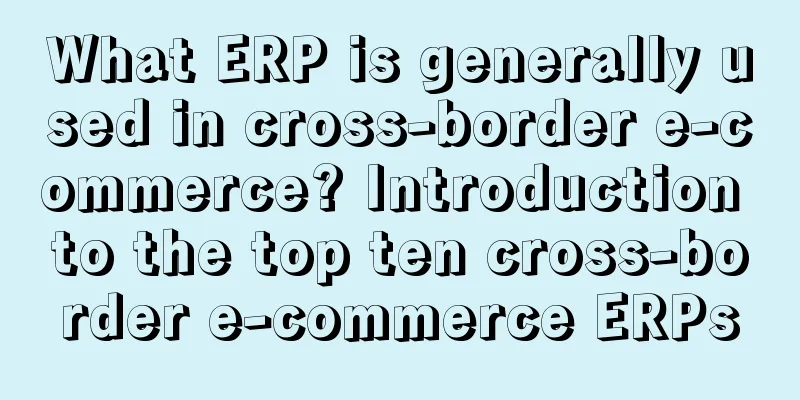What ERP is generally used in cross-border e-commerce? Introduction to the top ten cross-border e-commerce ERPs

|
Merchants in the cross-border e-commerce industry are basically using erp systems to manage some basic operations of the store, such as order management, customer service management, etc., because compared with the functions of the store backend, erp can be more localized to adapt to the needs of merchants, so what erp is generally better? What ERP is generally used in cross-border e-commerce? 1. Global Trading Assistant ERP Trading Assistant is a third-party ERP software authorized by AliExpress. It can be operated locally or on the web. It can be used with the same account. Because it is an ERP for the AliExpress platform, the AliExpress store charges 299 yuan/year, and other e-commerce platforms can be connected for free, which is very affordable. The functions of Global Trading Assistant are used to upload products, place orders and ship, move data, and quickly migrate products from other platform stores to AliExpress, and deeply connect with the AliExpress platform. 2. Saihe ERP You get what you pay for. This ERP is excellent, but the price may be unacceptable to many sellers, as it costs 8,000 per month, or 96,000 per year. In addition, the functions are not sold separately, and it supports automatic replenishment, listing and delisting, sales statistics, browse rate and other functions. Strong sellers may consider it. 3. SpeedPulse ERP Sumai is also an ERP that focuses on the AliExpress platform. Its functions meet the requirements of most sellers. It supports order processing, product listing and other functions. The docking platforms include AliExpress, Dunhuang, Amazon, eBay, wish, 1688, lazada, cdiscount, shopee, jomm, and tophatter. 4. Tongtu ERP Tongtu has a complete range of functions, including ERP (listing) and listing (order) systems. The fees are reasonable and calculated based on the order volume. You pay as you go, and there is no account limit. The platforms it connects to include eBay, AliExpress, Wish, Lazada, PM, Newegg, Mercadolibre, etc. It is quite good in terms of ordering and warehousing, and the operation page is simple and fast. 5. Mango Store Manager ERP The Mango store manager's page has a simple design style, is easy to operate and understand, has good after-sales service, and is fully functional. It is very suitable for novice sellers and can be used after registration. 6. Mabang ERP Mabang ERP was founded by professional sellers, so it knows exactly what functions sellers need. The ERP it designs can meet the basic needs of sellers, is very stable, and is connected to most cross-border e-commerce platforms. Mabang's annual fee of 3,800 is relatively cheap, with a free trial for one week, or monthly fees based on functions, and there are still many people using it. 7. Dianxiaomi ERP Dianxiaomi's charging method is more user-friendly, with multiple packages to choose from. Whether it is a large, medium or small seller, there is a suitable fee package. Up to now, the functions have been very complete, and the functional needs of sellers can be met. Almost all e-commerce platforms have been connected, so every cross-border e-commerce platform has sellers using Dianxiaomi. 8. Shengtu Cross-border ERP Provide cross-border e-commerce exporters with intelligent and automated management functions from goods -> procurement -> inventory -> sales and delivery -> after-sales -> data report analysis. 9. Yicang ERP It can manage the seller's procurement suppliers, purchase in-transit product data, warehouse storage and destocking management, outbound logistics management, corporate financial data, commodity data analysis, etc. It is a complete enterprise business management system. 10. ASINKING ERP ASINKING is a professional Amazon one-stop management system that helps sellers build a complete data-based operation closed loop. ASINKING provides sellers with accurate, comprehensive and multi-dimensional real-time data to help sellers improve efficiency and optimize processes in sales, inventory, advertising, customer service and operation management. There are still many ERPs to choose from for cross-border e-commerce, some of which are free and some are paid. However, it is understood that many free ERPs can only provide the simplest functions, and other functions require payment to activate. Paid ERP software will provide a better experience, so it is recommended that you give priority to paid ones. Recommended reading: Is it suitable to do cross-border e-commerce at the age of 50? What are the daily operations? What are the new skills for opening a cross-border e-commerce store? What should you pay attention to? Can one person do Shopee cross-border e-commerce? How to do it? |
<<: How much does a cross-border e-commerce erp system cost? What are the commonly used erp systems?
Recommend
Private domain content creation: 10 "tricks and techniques" to teach you how to increase your influence!
This article starts with creating good private dom...
Is it true that these types of people are not suitable for cross-border e-commerce? What are the conditions?
In the Internet age, more and more people choose t...
The "solution" you choose determines how expensive your product can be sold!
This article raises a question: There are countles...
TikTok: Outbreak, Chaos and Crisis
Douyin Dabo is not only an increase in sales, but ...
What to do if Amazon restricts replenishment? How to avoid replenishment restrictions?
When opening a store on Amazon, replenishment is a...
Tik Tok and Bilibili are jealous of each other
A new APP "Qingtao" released by Douyin h...
Cute pets and good-looking content dominate the charts, all of Tik Tok’s hottest titles for February are here!
This article focuses on the "Douyin February ...
Get ready for Double Eleven! 7 live streaming sales tactics to use right now!
Double Eleven is around the corner, and it’s time ...
What is a good Amazon order conversion rate? How to calculate it?
There are still many merchants opening stores on t...
Brand and price determine life and death
What is the most important thing for a brand? This...
What are the rankings of cross-border third-party payment platforms? Which one is better?
On cross-border e-commerce platforms, people gener...
Does Amazon China work overtime? What is it like to work at Amazon China?
?In recent years, as Amazon China continues to gro...
In the short video business war, you have to be able to twist
The "subject three" dance skills of the ...
What is the tutorial for overseas shopping on eBay? What issues should I pay attention to?
There are actually quite a lot of merchants doing ...
I no longer believe in buying traffic from outside, but can I count on the video account?
WeChat is gradually shifting more traffic to video...









